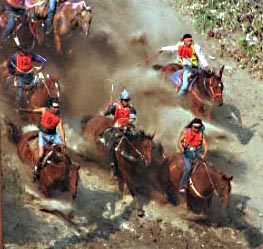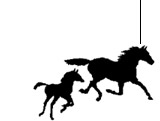|
Omak Suicide Race
The deadliest horse race in the world
Vivian Farrell
Int'l Fund for Horses
May 22, 2005
By definition suicide is the act or an instance of intentionally killing oneself. Murder, by definition, is to kill brutally or inhumanely; to destroy.
Year after year in Omak, a small town in Eastern Washington State, the local rodeo holds as it main attraction an event called "The World-Famous Omak Suicide Race." This race regularly and routinely kills horses. It is not suicide. It is murder.
First Leg The Downhill Death Drop

Horses are charged and whipped down "Suicide Hill" after a galloping start, an almost complete vertical drop of approximately 225 feet at a 62 degree angle, very much like a steep staircase.
Studies carried out regarding equine vision have found that because of the position of the horse's eyes, which are set wide apart on either side of the head, there is blind spot directly in front of the forehead. Researchers believe that this "blind field" is the width of the horse.[1]
This means when a horse is catapulted down a sharp decline he cannot see far enough ahead to judge where to land his feet. This means that the horse will not realize where the ground is until it comes rushing up beneath him, crashing the weight of his 1,000 plus pound body blindly onto delicate legs not intended to bear such a sudden, sharp impact. This also means he cannot see the horses ahead of him, and therefore will crash into them unwittingly.
Anyone who has ever watched a Western will recall when a horse is asked by his rider to carry him down a steep incline, even in hot pursuit, how carefully the horse proceeds down it, measuring every step.
Add to this the fact that there are numerous horses also forced to run at breakneck speed surrounding him, blindly facing the same dangerous predicament, and the results can be hazardous and sometimes deadly collisions. This is a frequent occurrence in the Omak Suicide Race, and not only expected but also heralded as part of the excitement.
The consequences can be serious injury and even death. Notwithstanding the physical dangers, mentally it is a terrifying experience for the horse.
In steeplechasing, an event I have personal experience of, a horse must memorize the position of the fence he is approaching, and relies on his rider to tell him when to jump as the horse loses sight of it. At this point, all the horse can see is the landing side. This takes months, if not years, of intensive training, highly tuned communication between horse and rider, and ostensibly, a great deal of trust. Even at the highest levels of this type of competition, there are sadly still errors in judgment that cause injuries to horses and jockeys.
In the Omak Suicide Race, many of the horses are "on loan" to the riders, where none of these skills are in place. No responsible, caring owner would subject their horse to this sort of abuse, risking his horse's very life and well-being, and certainly not one who had the type of relationship as set out above.
In the recent running of the 131st Preakness Thoroughbred race in Baltimore, Maryland, the eventual winner was cut across by the frontrunner. Afleet Alex was snatched up by his jockey, but the horse still clipped the heels of the horse in front of him, stumbled to his knees, only to right himself and run on to win the race.
Although one could argue that a certain amount of luck was involved, it was much more a testimony to the excellent physical conditioning of the horse and lightening fast reflexes of the rider that avoided catastrophe and a subsequent pile up spelling injury and death to many horses and riders.
Unlike the Omak Suicide Race where a horse has to continually struggle with his footing in the deep sands, this occurred on an even, flat surface on which these horses have been trained for the whole of their athletic careers and are sure of the surface beneath their hooves.
The participants were Thoroughbreds and jockeys at the peak of their abilities. You could not draw a comparison between the horses and riders participating in the Omak Suicide Race with any rationality.
During the running of a race, a professional jockey, when sensing possible injury by signs of distress usually signaled by a change in his horse's action, will immediately "pull up" or slow his mount down and steer him out of the way of the other runners -- in order to protect the horse and prevent further injury.
Riders in the Omak Suicide Race push their mounts ahead in an effort to win at any cost and despite any signs of distress or injury. A documented 20 horses have died since 1983 sustaining injuries such as broken legs, a fractured knee, a fractured pelvis, a broken shoulder or from heart attacks from overexertion.
Injuries such as these often occur in pile ups on Suicide Hill which are the leading cause of death in the Omak Suicide Race. Horses lose their footing and somersault head over heel down the hill. Others trip over or collide with falling horses.
Second Leg The Swim
At the bottom of the downhill death dash, the horses competing in the Omak Suicide Race who have survived the first leg are immediately faced with the rocky Okanogan River and a frenzied swim more than a football field across. Horses who have already sustained injuries, panic or get caught up in the reins, drown. Some horses land in the rocky waters sideways having lost their balance and direction following the downhill death dash, and in an attempt to right themselves to swim, wrench their necks and backs, sustaining further trauma.
Horses are not natural swimmers and tend to panic temporarily because they cannot feel the ground beneath them. When they swim they will employ a trotting motion and "a breathing pattern characterized by brief inspiration and prolonged expiration." The difficulty in breathing when swimming is probably due to the pressure applied to the chest and abdomen of the horse by the water and the fact that the horse does not have the rhythm of body and abdominal movements that serve to help the breathing process" when he is on land.
"[It] it should be noted that swimming also results in relatively high blood pressures compared with galloping and that some horses have experienced nose bleeding after a bout(s) of swimming. As such, swimming is not recommended for horses with respiratory disease and it is also contraindicated in horses with back injuries."[2]
Because there is no support from the ground and there is little or no resistance from the water, the amount of energy required to move forward in the water is significantly greater than that required to move forward on land. It takes approximately four complete swimming strokes to cover the same distance as one galloping stride on land. Based on this approximately 500 yards is about equal to a one mile gallop.
As stated before, notwithstanding the physical dangers, the experience is mentally harrowing for the horse.
Third and Final Leg The Uphill Sprint
Already terrified, exhausted and possibly injured, the horses face the third and final leg of the Omak Suicide which is a punishing and backbreaking uphill sprint.
When a horse's gait quickens to a gallop, his breathing is linked to the rhythm of his hoof beats. During high-intensity exercise, this rhythmic breathing lowers oxygen intake, producing a buildup of lactic acid and carbon dioxide (CO2) concentration, causing fatigue and cramping, much like when a human athlete gets a "stitch."
To bring the body back to normal, CO2 moves to the bloodstream and is expelled from the lungs. Lactic acid is neutralized in various organs, including muscles. With continuous overexertion, the recovery process is disturbed. In this situation, acid buildup, called acidosis, further reduces oxygen flow to the muscles, creating long-lasting fatigue and [permanent] muscle damage.[3]
Other Factors
The Omak Suicide Race takes place in four heats over four days.<
In the past 21 years, 20 deaths have been documented. In 2004 alone, three horses were killed in the first heat alone.[4]
Like humans, horses are imprinted with every experience they have encountered since birth. They are highly sensitive, instinctual animals, and much like us, think about not only what they have been through but also about what they are about to endure.
Horses have sharper and broader hearing ranges than humans. Loud noises are painful to a horse's ears. Their sense of smell is also acute. Horses "smell" the fear in other horses, which further perpetuates their own.
Their sensitivity to sound and smells is why they become hard to handle when they are subjected to surroundings and activities they are unaccustomed to -- they are receiving conflicting messages from their senses. The tumult of such an occasion as the Omak Suicide Race must be an assault on their senses that is debilitating and petrifying.
Culture
To say the Omak Suicide Race is a cultural event is not justification for the inhumane treatment and murder of horses.
Cultural Relativism is a false theory of justification. Cultural Relativism has been refuted in the United States and the rest of the First World. However, it is still being used in certain circles to justify brutality committed against animals.
No caring society subjects another living being to such blatant cruelty - and death - in the name of culture or entertainment. There comes a time when we as a people must move forward and leave behind those acts and events that are unacceptable in a civilized society, regardless of how steeped in tradition, and the Omak Suicide Race is certainly one of them.
Conclusion
The horses who have been forced to take part in the Omak Suicide Race have suffered enormous physical abuse by way of broken bones, irreparable tendon damage from falls and collisions, and long-term muscle damage from overexertion. From a lifetime of experience with horses, it is my opinion that they have endured psychological trauma from which they can never recover.
Horses in the Omak Suicide Race have died from strokes, heart attacks, broken bones, and gruesomely by drowning. They did not participate willingly. It was not their intention to die.
It is not a suicide race. It is murder.
The Omak Suicide Race is scheduled for August 11-14, 2005.
================
[1] New Insights into Horse Vision, Equine Veterinary Journal (1999) 31(5) 384-390
[2] Horse Training Using Swimming and Heart Rates
[3] When Champs Get Cramps, by Darek Gondor
[4] A List of Horse Killed Since 1983
About the Author
Vivian Farrell is the founder and President of the Int'l Fund for Horses. Married to a Thoroughbred racehorse trainer, she worked as a professional Thoroughbred flat racing and steeplechasing photographer and exercise rider. She was a prize-winning barrel racer as a young girl in Texas and rode in amateur Ladies' races in England.
Further Information
Press Archives, Progressive Animal Welfare Society, PAWS
Omak Suicide Race Photographs (pdf)
This article copyright © Vivian Farrell, 2005. All Rights Reserved.
"Help us lead Canada's horses away from barbarism . .
and into the protected pastures of a civilized
nation."
|


